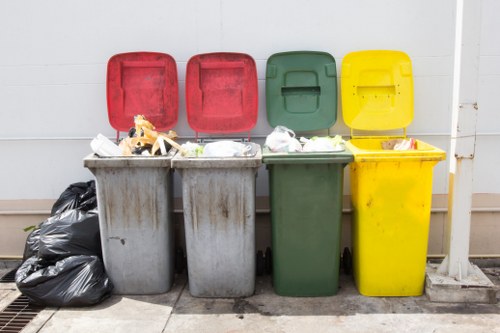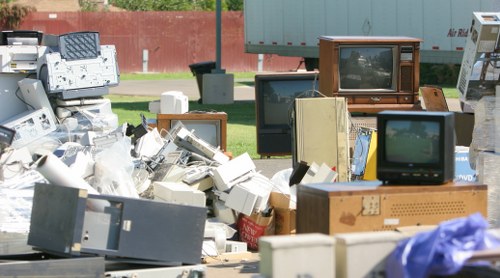Comprehensive Guide to House Clearance in Council Large Item Collection
Understanding House Clearance

House clearance involves the removal of unwanted items from a residential property. Whether you're downsizing, moving, or dealing with an estate, clearing out large items can be a daunting task. This process ensures that your home is free from clutter, making it easier to manage your living space or prepare for sale.
When dealing with council large item collection, it's essential to understand the specific guidelines and services your local council offers. This can help streamline the process, ensuring that your items are disposed of responsibly and efficiently.
Many councils provide scheduled collections for large items, which can include furniture, appliances, and other bulky possessions. Utilizing these services can save you time and effort, as well as reduce the environmental impact of disposing of large items.
Types of Items Collected

Council large item collections typically accept a variety of items. However, it's crucial to know what is and isn't accepted to avoid any inconvenience.
Furniture
Old sofas, chairs, tables, and beds can usually be collected. Ensure that these items are not in a hazardous condition, such as being infested with pests or containing harmful materials.
Appliances
Large appliances like refrigerators, washing machines, and ovens are often part of the collection service. Some councils may require that these items are not operational or contain no refrigerants.
Electronics
While some councils accept electronics, it's best to check as many require these items to be taken to designated recycling centers due to their hazardous components.
Scheduling Your Collection

To schedule a large item collection, contact your local council through their website or customer service center. Provide a detailed list of items you wish to dispose of, and they will arrange a suitable time for the collection.
It's advisable to prepare the items in advance, placing them in accessible locations to facilitate a smooth collection process. Clear pathways and proper labeling can help the collection team work efficiently.
Some councils offer recurrent collection services for ongoing needs, which can be useful for regular decluttering or during large projects like renovations.
Costs and Fees

Many council large item collections are free of charge, especially for essential waste. However, there may be fees associated with non-standard items or additional collections.
- Standard Collection: Typically free for a set number of items per year.
- Additional Collections: May incur a fee depending on the number and type of items.
- Prohibited Items: Items like asbestos or hazardous waste may require special disposal methods and incur extra costs.
Always check with your local council to understand the fee structure and ensure that you comply with their regulations to avoid unexpected charges.
Some councils offer discounts or fee waivers for vulnerable individuals or those in specific circumstances, so it's worth inquiring about available assistance programs.
Environmental Considerations

Responsible disposal of large items is vital for environmental sustainability. Councils often work with recycling centers and charities to minimize landfill waste.
By utilizing council collection services, you contribute to recycling efforts, ensuring that usable items are repurposed or donated rather than discarded irresponsibly.
It's also an opportunity to declutter sustainably, promoting a cleaner and healthier environment for the community.
Preparing for Collection

Proper preparation is key to a hassle-free house clearance. Start by sorting items into categories: keep, donate, recycle, and dispose.
Sorting and Decluttering
Review each room systematically, assessing which items are necessary and which can be removed. This not only makes the clearance process easier but also helps in organizing your space post-clearance.
Hazardous Materials
Identify and separate hazardous materials such as chemicals, batteries, and electronic waste. These items require special handling and should not be mixed with regular large items.
Accessibility
Ensure that all items to be collected are easily accessible on the day of collection. Clear pathways and designate specific areas for the items to streamline the process.
Benefits of Using Council Services

Opting for council large item collection offers several advantages:
- Convenience: Scheduled collections save you the effort of transportation and disposal.
- Cost-Effective: Often free or low-cost compared to private removal services.
- Environmental Responsibility: Ensures proper recycling and disposal, reducing landfill burden.
- Regulatory Compliance: Adheres to local disposal regulations, avoiding fines.
These benefits make council services an attractive option for effective and responsible house clearance.
Furthermore, utilizing council services supports community efforts in maintaining a clean and sustainable environment.
Alternative Disposal Options

While council large item collection is a reliable option, there are alternative methods to consider based on your specific needs.
Private Removal Services
Hiring a private removal company can offer more flexible scheduling and personalized service. This is ideal for urgent or large-scale clearances.
Recycling Centers
For items not accepted by the council, designated recycling centers provide a responsible way to dispose of them. Check local listings for the nearest facilities.
Charitable Donations
Donating usable items to charities can benefit those in need while reducing waste. Organizations often accept furniture, appliances, and other household items.
Tips for an Efficient Clearance

Maximize the efficiency of your house clearance with these practical tips:
- Plan Ahead: Schedule your collection in advance to avoid last-minute stress.
- Inventory Management: Keep a detailed list of items to track what’s been removed.
- Safety First: Handle heavy items with care to prevent injuries.
- Clear Communication: Inform all household members about the clearance process to ensure cooperation.
- Stay Organized: Keep sorting items into designated areas to streamline the collection.
Implementing these strategies can make the clearance process smoother and more manageable.
Additionally, maintaining organization helps in repurposing or selling items you wish to keep.
Legal and Regulatory Considerations

Compliance with local regulations is essential when disposing of large items. Failure to adhere can result in fines or legal issues.
Local Council Guidelines
Each council has specific rules regarding what can be collected and how. Familiarize yourself with these guidelines to ensure a compliant clearance.
Permits and Restrictions
Some areas may require permits for large waste disposal or have restrictions on the frequency of collections. Check with your local authorities to avoid any violations.
Environmental Regulations
Disposal of certain items, such as electronics or hazardous materials, is regulated to protect the environment. Ensure these are handled according to the prescribed methods.
Post-Clearance Clean-Up

After the large items are removed, a thorough clean-up enhances the overall appearance and functionality of your home.
Deep Cleaning
Consider hiring professional cleaners to address areas previously occupied by large items. This includes vacuuming, mopping, and sanitizing surfaces.
Repurposing Space
The removal of clutter creates opportunities to redesign and optimize your living spaces. Use this chance to rearrange furniture or create new storage solutions.
Final Inspection
Conduct a final walkthrough to ensure all unwanted items have been cleared and the space meets your expectations.
Frequently Asked Questions

Addressing common queries can help clarify doubts about the house clearance process.
How often can I schedule a large item collection?
Most councils allow a certain number of free collections per year, with additional collections available for a fee.
What items are not accepted?
Items like hazardous waste, asbestos, and certain electronics may not be accepted. Check with your council for specific restrictions.
Can I donate items instead of disposing of them?
Yes, donating items is encouraged. Many charities accept furniture, appliances, and other household goods in good condition.
Conclusion

House clearance in council large item collection is an effective way to manage unwanted bulky items responsibly. By understanding the process, types of items accepted, and the benefits of using council services, you can ensure a smooth and environmentally friendly clearance experience.
Remember to plan ahead, comply with local regulations, and consider alternative disposal options to maximize the efficiency of your house clearance.
Take the first step towards a clutter-free home by contacting your local council today. Contact us today to schedule your large item collection and embrace a cleaner, more organized living space.
